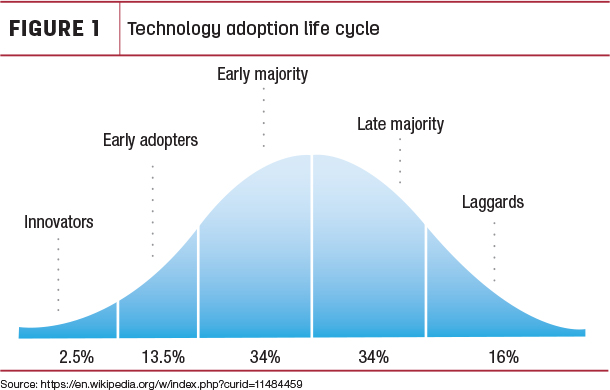Three minutes was all it took. Three minutes and my groceries were purchased, loaded in my trunk and I was pulling out of the Walmart parking lot. Now, for those of you that do the shopping, you know a quick trip to Walmart – even at self-checkout – can take much, much longer. Despite my now-apparent love for grocery pickup, I wasn’t always a believer. Whether it was trusting someone to select quality produce, or my tendency to stick with the familiar, it took a pandemic before I actually gave it a try. Needless to say, after only a couple of times, I was touting its convenience to my friends and family.
This got me thinking about the technology adoption life cycle and Rogers’ bell curve. At some point in my college career, I remember learning about this model and the five characteristics used to describe how quickly people accept a new product or innovation.
Innovators – This group thinks outside the box and is the first to try anything new. These people definitely don’t go with the flow.
Early adopters – This group welcomes new ideas, but they like to be a little more informed than the innovators. They are typically the leaders and the frontiers of change.
Early majority – This group needs some time to pass before trying something new, but they still adopt ideas faster than the average person. They tend to read reviews and ask for recommendations before trying something new.
Late majority – These are the skeptics. They require a lot more research and proof before adopting a new product or idea. They tend to accept something new based on peer pressure.
Laggards – This group is resistant to change and firm on tradition (flip phone, anyone?).

When thinking about this model, online grocery shopping, pickup or delivery is still a relatively new concept, but current events have definitely sped up its growth – maybe even faster than the typical process. In fact, according to a Beef Checkoff online survey, 67% of consumers said they occasionally purchased groceries online, and more than 70% of those consumers said they started buying digitally during the pandemic.
This opens up a lot of questions as to how this will look for the beef industry going forward.
Will customers continue to buy their groceries online after the pandemic? Will beef find its way into their shopping carts? And something a little more futuristic to consider, could we see a day where virtual shopping replaces in-store shopping?
Ding! Oh, would you look at that; my order is ready.








